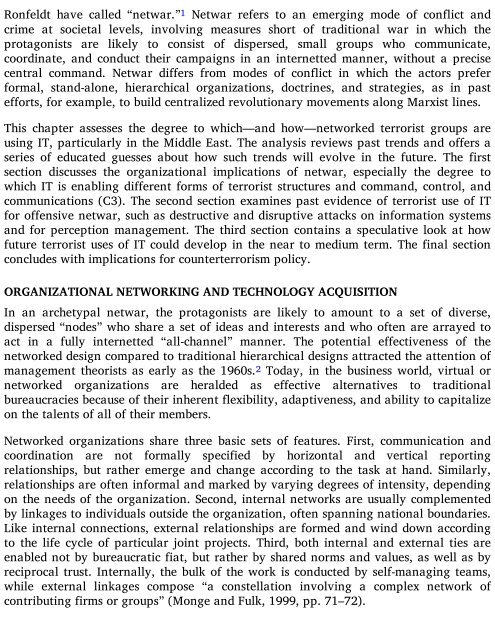RAND_MR1382
Create successful ePaper yourself
Turn your PDF publications into a flip-book with our unique Google optimized e-Paper software.
Ronfeldt have called “netwar.” 1 Netwar refers to an emerging mode of conflict and<br />
crime at societal levels, involving measures short of traditional war in which the<br />
protagonists are likely to consist of dispersed, small groups who communicate,<br />
coordinate, and conduct their campaigns in an internetted manner, without a precise<br />
central command. Netwar differs from modes of conflict in which the actors prefer<br />
formal, stand-alone, hierarchical organizations, doctrines, and strategies, as in past<br />
efforts, for example, to build centralized revolutionary movements along Marxist lines.<br />
This chapter assesses the degree to which—and how—networked terrorist groups are<br />
using IT, particularly in the Middle East. The analysis reviews past trends and offers a<br />
series of educated guesses about how such trends will evolve in the future. The first<br />
section discusses the organizational implications of netwar, especially the degree to<br />
which IT is enabling different forms of terrorist structures and command, control, and<br />
communications (C3). The second section examines past evidence of terrorist use of IT<br />
for offensive netwar, such as destructive and disruptive attacks on information systems<br />
and for perception management. The third section contains a speculative look at how<br />
future terrorist uses of IT could develop in the near to medium term. The final section<br />
concludes with implications for counterterrorism policy.<br />
ORGANIZATIONAL NETWORKING AND TECHNOLOGY ACQUISITION<br />
In an archetypal netwar, the protagonists are likely to amount to a set of diverse,<br />
dispersed “nodes” who share a set of ideas and interests and who often are arrayed to<br />
act in a fully internetted “all-channel” manner. The potential effectiveness of the<br />
networked design compared to traditional hierarchical designs attracted the attention of<br />
management theorists as early as the 1960s. 2 Today, in the business world, virtual or<br />
networked organizations are heralded as effective alternatives to traditional<br />
bureaucracies because of their inherent flexibility, adaptiveness, and ability to capitalize<br />
on the talents of all of their members.<br />
Networked organizations share three basic sets of features. First, communication and<br />
coordination are not formally specified by horizontal and vertical reporting<br />
relationships, but rather emerge and change according to the task at hand. Similarly,<br />
relationships are often informal and marked by varying degrees of intensity, depending<br />
on the needs of the organization. Second, internal networks are usually complemented<br />
by linkages to individuals outside the organization, often spanning national boundaries.<br />
Like internal connections, external relationships are formed and wind down according<br />
to the life cycle of particular joint projects. Third, both internal and external ties are<br />
enabled not by bureaucratic fiat, but rather by shared norms and values, as well as by<br />
reciprocal trust. Internally, the bulk of the work is conducted by self-managing teams,<br />
while external linkages compose “a constellation involving a complex network of<br />
contributing firms or groups” (Monge and Fulk, 1999, pp. 71–72).










![Genki - An Integrated Course in Elementary Japanese II [Second Edition] (2011), WITH PDF BOOKMARKS!](https://img.yumpu.com/58322134/1/180x260/genki-an-integrated-course-in-elementary-japanese-ii-second-edition-2011-with-pdf-bookmarks.jpg?quality=85)
![Genki - An Integrated Course in Elementary Japanese I [Second Edition] (2011), WITH PDF BOOKMARKS!](https://img.yumpu.com/58322120/1/182x260/genki-an-integrated-course-in-elementary-japanese-i-second-edition-2011-with-pdf-bookmarks.jpg?quality=85)





